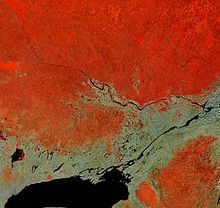Ottawa River
- This is about the river in Canada. For other uses, see Ottawa River (disambiguation).
The Ottawa River (French: Rivière des Outaouais) is a river in the Canadian provinces of Ontario and Quebec. It defines for most of its length the border between these two provinces.
Geography
The river rises from its source in Lake Capimitchigama in the Laurentian Mountains of central Quebec, flows west to Lake Timiskaming where it reaches the Ontario border, then flows southeast to Ottawa and Gatineau where it tumbles over the Chaudière Falls and further takes in the Rideau and Gatineau Rivers.
The Ottawa River drains into the Lac des Deux Montagnes (Lake of Two Mountains) and the Saint Lawrence River at Montreal. The total length of the river is 1,271 km, and it drains an area of 146,000 km², 65% in Quebec and the rest in Ontario. The average waterflow measured at Carillon dam, near the Lake of Two Mountains, is 1,950 m³/s, and it can vary from 700 to 8,000 m³/s.
Major tributaries include:
- Bonnechere River
- Coulonge River
- Gatineau River
- Kipawa River
- du Lièvre River
- Madawaska River
- Mattawa River
- Mississippi River
- Montreal River
- Rivière du Nord
- Petawawa River
- Rideau River
- Rouge River
- South Nation River

Communities along the Ottawa River include (in down-stream order):
Geology

Following the retreat of the glaciers from the area at the end of the last ice age, the Ottawa River valley was flooded by an arm of the Atlantic Ocean known as the Champlain Sea. Fossil remains of marine life have been found in marine clay formed during that time. Sediment deposits from this period have resulted in areas of poor drainage and the presence of large bogs in some ancient channels of this river. Another consequence was the formations of large deposits of a material commonly known as Leda clay; these deposits become highly unstable after heavy rains. Numerous landslides have occurred as a result. The former site of the town of Lemieux, Ontario collapsed into the South Nation River in 1993; however, the residents had already been relocated because of the suspected instability of the earth in that location.
Large numbers of Canada Geese, ducks, gulls and shorebirds take advantage of spring flooding and wetlands in the Ottawa River valley during migration. Ducks also overwinter in sections of the river that do not freeze over.
The Ottawa River lies in the Ottawa-Bonnechere Graben, which is a Mesozoic rift valley that formed 175 million years ago.
History

The river was an important trade route for the Algonquin people, who called it Kitchissippi, "Great River". Some early European explorers, possibly considering the Ottawa River to be more significant than the Upper Saint Lawrence River, applied the name River Canada to the Ottawa River and the Saint Lawrence River below the confluence at Montreal. As the extent of the Great Lakes became clear and the river began to be regarded as a tributary, it was variously known as the Grand River, "Great River" or Grand River of the Algonquins before the present name was settled upon. This name change resulted from the Ottawa peoples' control of the river circa 1685. However, only one band of Ottawa, the Kinouncherpirini or Keinouch, ever inhabited the Ottawa Valley.
In 1615, Samuel de Champlain and Étienne Brûlé, assisted by Algonquin guides, were the first Europeans to travel up the Ottawa River and follow the water route west to Georgian Bay. For the following two centuries, this route was used by French fur traders to Canada's interior.
In the early 19th century, the Ottawa River and its tributaries were used to gain access to large virgin forests of white pine. A booming trade in timber developed, and large rafts of logs were floated down the river. In 1832, the Ottawa River was connected to Lake Ontario via the Rideau Canal. Today, Outaouais Herald Emeritus at the Canadian Heraldic Authority is named after the river.
Several hydroelectric dams have been constructed on the river. However, it is still extensively used for recreational boating.
See also
- Rivière des Mille Îles
- Rivière des Prairies
- List of Ontario rivers
- List of Quebec rivers
- List of hydroelectric stations
- List of crossings of the Ottawa River
